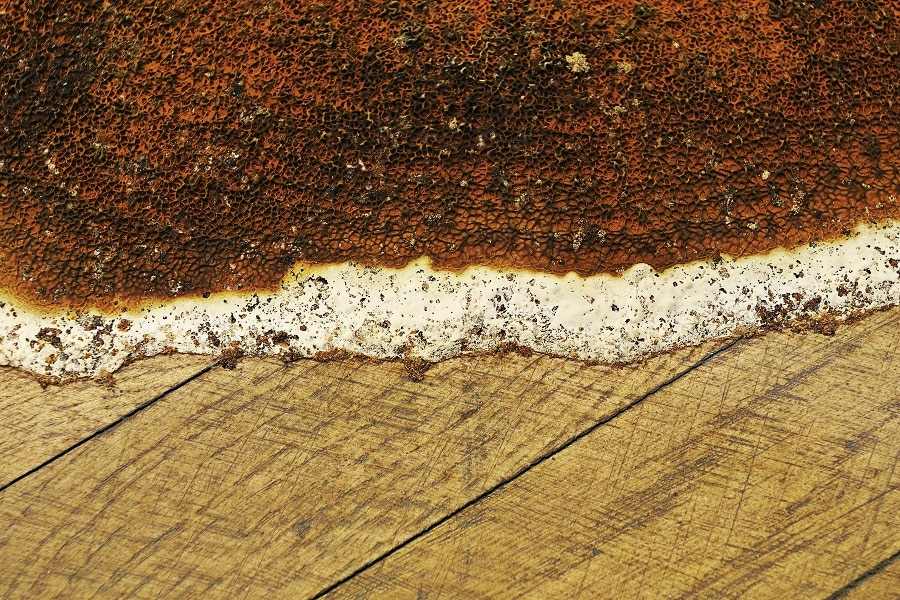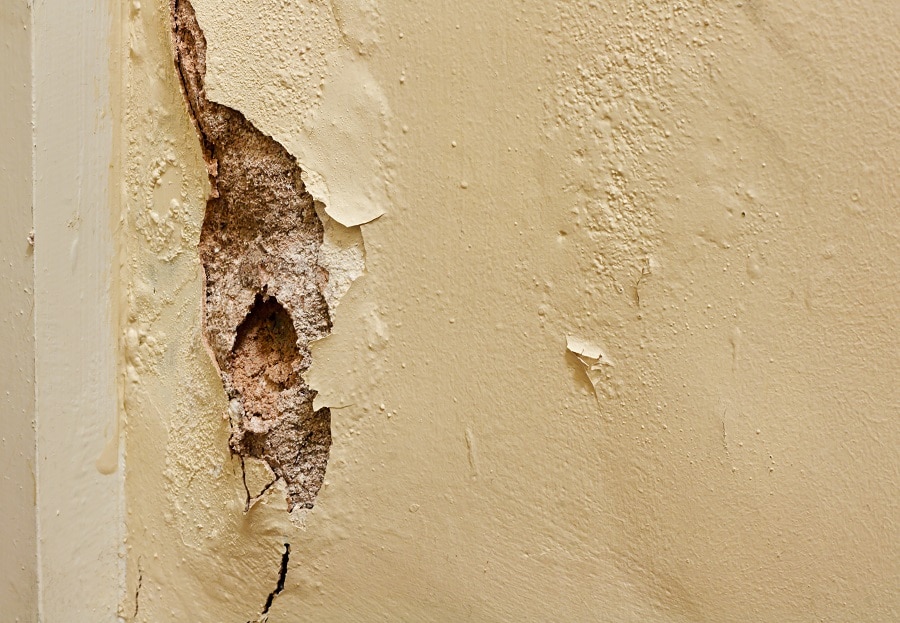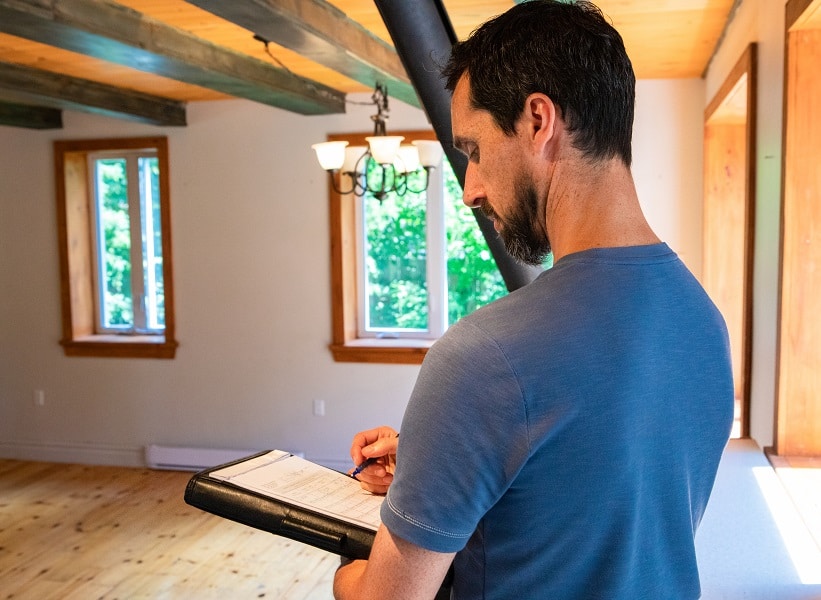What is dry rot?
Dry rot is a common term for various kinds of wood-decay fungus. The wood is broken down by fungi, as the Mycelium decomposes the wood, resulting in fine dust particles that are made of sawdust and wood chips, forming colonized areas that are referred to as fungal blooms. Dry rot is caused by fungal spores which require a suitable place to land and start their colonies before spreading through the underlying wood. Many of the spores are already present in woods that are already affected by dry rot and in the soil.
This means wood can get damp and stay damp for considerable periods of time below 15% relative humidity. Dry Rot does far greater damage than Wet Rot, you can be surprised to learn that dry rot fungus will invade structural wood in your property while remaining undetected. It normally occurs where you are not looking. This could be found behind the plaster, beneath your floorboards, or even in your loft. This is why it is important to know the signs and symptoms of dry rot and to have it handled fast.
Our Guarantee
- upto 30 year guarantee
- customer focused team
- 20 years combined experience
- portfolio of satified customers
- attention to detail
- Construction line accreditation
- public liability insurance
- CHAS accreditation
What is the difference between dry rot and wet rot?
Dry rot and wet rot have different spores/species, meaning that they look different. Unlike dry rot which can spread in minimal amounts of water, wet rot is dependent on significant moisture to spread. One of the main differences between wet rot and dry rot is that wet rot spreads much faster. This is because the use of oils within timbers effectively fills the capillaries that Dry Rot requires for infestation. Dry rot is the greatest danger when it comes to timber damage, it spreads throughout buildings, frequently hidden by wallpaper or carpets. On the other hand, wet fungus occurs when timber becomes wet for long periods of time.
Call Our Sussex Damp Experts team now for quote, consultation and advice:
Call on 01273 257 765.
What are the causes of dry rot?
A lot of fungi species cause dry rot. Serpula Lacrymans is the most common one in Lewes. If you don’t fix it soon, it could cause serious damage to your home. This would damage the integrity of your structural wood, and thus the structural integrity of your whole residence. Dry rot attacks when moisture levels are too high in your timber. This will attract the fungus that will use this moisture to extract nutrients. The expression “dry rot” is used to contrast between “wet wood” and “dry wood rot.”
Wet wood survives on the dry rot. These hyphae need only 20% moisture to survive, while fungal spores need more than 30% moisture to generate hyphae after this. They are the only living organism that can form three-dimensional networks of hyphae, which can lead to mycelia that spread over considerable distances. The wood fibers (cellulose) are rotten or broken down by the fungus, and the water is removed. You’ll need a private survey to tell if your wood deterioration is caused by dry rot or another kind of fungus. This is important as the remedies for these damages can vary based on the actual cause.

The dangers of dry rot in Lewes
Dry Rot Effect on your Property
The biggest problem with dry rot is that it will rapidly attack your home’s structural integrity. It will spread along the structural timbers inside your property and begin to break them down. In serious circumstances, it can cause various parts of your house to fall apart. Dry rot, however, does not attack your brick or stone; it only travels across it. Hence, regular checks are essential.
Dry Rot can cause extensive damage, and it is vital that you get to it as soon as possible. When fungus is evident, you need to call a restoration expert right away to prevent mold growth from worsening any damage that may be apparent. If you think you may have a damp problem use our home survey form on our website.
Dry Rot Effect on Your personal health
It’s not the disease that causes dry rot that is dangerous. Regrettably, if dry rot does occur, the structural damage may be extensive to your health. This is especially precarious for the elderly, children and anyone with respiratory conditions such as asthma.
What are the Warning Signs of Dry Rot?
If you discover dry rot early on, you’ll be able to save yourself time and money. If you see some of the signs and symptoms listed below, a complete examination is recommended.
-
The beginning of the dry rot cycle
The spores of the dry rot fungus are carried by the wind across large distances. The insect cuts small holes into the wood and eats the sap that comes out. The fungus then hyphae will germinate and start to spread through the timber if the wood gives them enough nutrients. As the fungus grows, strands of this tissue called hyphae form spiderweb-looking collections called mycelium. Mycelium is white or grey This mycelium can also reach into your properties bricks, mortar and wood to try and reach more of your timber.
-
Your timber is damaged.
You are likely to start noticing rot issues if your timber begins to dry out. Your timber may collapse as a result of this. You will probably note the dry rot blacken the color of your wood. Cuboidal cracking on walls can be caused by a multitude of dry rot. Cuboidal cracking/splitting is the result of timber breakage around 50 mm. At its worst, the fungus rots the timber, causing the white fungal hyphae to grow. Hyphae is a slime-mold and is an early symptom of dry rot.
-
Your timber will smell.
If you detect a distinct dour, you should have your timber checked for dry rot. This happens, even when you can’t see an outburst of dry rot. The smell doesn’t necessarily mean dry rot is present.
-
Your timber will have fungus bodies on it.
Dry rot is the most noticeable kind of wood rot and one of the final stages of fungal attack. Those cute little mushroom-like fruiting bodies can start joining themselves with your wood. If it becomes dry, dry rot can no longer feed on the wood so it will pop out spores instead.
-
Your timber will have spore dust.
Dry rot does not just occur in timber that is already affected. However, if splotches of dust rusty color accompany dry rot spores, it can be a sign of dry rot. In the last step of the dry rot stage, fruiting bodies yield spore dust.
Dry Rot Treatment in Lewes

A Dry Rot infestation can only occur when moisture levels are above 20%. The first prevention step to eradicating the presence of the fungus is the monitoring of moisture levels in your property. Then the moisture levels will be under your control. Consult a professional for a proper treatment of your dry rot.
For the removal of infected timber and any remedial work, you can rely on Sussex Damp Experts . Any affected timber should be handled by a professional. A professional damp proofing expert has the knowledge of the exact treatment. Either injected into the timber, or cover the timber surface can timber be treated. There are also several preventative treatment options available. Such chemicals require precise concentrations and can have adverse side effects if mistakenly inhaled or injected.
Boron rods can also be inserted into your timber by an expert. Boron is a radioactive compound, which is why our damp proofing experts all wear the protective clothing. Through our damp proofing expert team, we will be able to identify some dry rot problems and determine the seriousness of the problem. Dry rots can lead to serious complications if left untreated for a long time. In order to protect a wooden structure, it’s critical to treat dry rot immediately. We will provide a damp proofing solution that is right for your needs. Please don’t wait until it’s too late. Call 01273 257 765 for today’s free survey and successful care if you suspect you have a problem with dry rot.
How can you prevent dry rot damage in Lewes?
Preventing dry rot is the first step of treatment. Wooden areas of the property, which capture ample water and which are subject to moisture/humidity, can contribute to a dry red infestation. Any activities that prohibit them from evolving are present here: Make sure there are no leaks in your house. Make available sufficient ventilation.
Well, ventilate and enclose the attic. Oxygenate crawlspaces very well. Seal basement and crawlspace floors to reduce ground moisture. Check all wall and roof flashing to ensure water is being directed properly. Stay out of sinks and drains. Check for plumbing/heating leaks if using a “wet” system. Because of the moist conditions required for dry rot fungus to feed and germinates, the best way to reduce the risk of dry rot is to minimize moisture levels. For instance, if you plug the leak, you prevent water from flowing into the pipe and causing future damage.
Speak to a Dry Rot specialist in Lewes
We are a team of highly trained experts who will fix your dampness and help you to avoid future damage. We will give you a free estimate for how much it will cost to get rid of all of it before we begin work. For some years, we have assisted thousands of Lewes homeowners with their damp problems, and we will support you as well. To book a free survey and quote, call us now 01273 257 765. An expert will be able to assess your dry rot problem. We are not tied to any special interest groups or companies, and can therefore give you advice on the treatments that will be best for you.

Our inspectors are completely trained and can recognise anything from dry red to moisture, including the solution, and provide you with a reasonable cost for any remediation. Dry rot is a long term problem, and can get worse if left unchecked, if you notice any signs of damage on your fence, it is better to contact our contractors right away. Sussex Damp Experts will be able to help you no matter what the nature of your damp issue is, email or call us on 01273 257 765
FAQ
Should dry rot be restored or replaced?
A certain level of dry rot can be repaired, but whether the damaged areas provide the house with structural stability, such as beams and joints, or even flooring, it is not recommended. Replace the wood in such a situation instead of repairing it. Whether you restore or rebuild the wood, it is better if you avoided the conditions that caused the rot to flourish in the first place or risked it coming back. Your roof leaks, broken gutters, or downspouts, plumbing leaks or insufficient ventilation should be inspected when considering a roof moisture accumulation You may consult a specialist to find and repair the problem.
Will you be able to treat my Dry Rot problem effectively?
With our expertly trained surveyors and specialists, a dry rot problem can be treated, rectified, and your timber can be protected for the future.
How do I discover how far Dry Rot has spread?
If you have traced the dry rot fungus quickly or not, a professional will identify the source of the problem. They will be able to trace the fungus in the different masonry and plaster from which it has spread.
How much can dry rot widen?
Dry rot spores can spread in anyplace with the right environmental settings. The reason is that they are carried in the atmosphere. If your timber has a moisture content of around 20%, and if it is in the open air, these conditions are attractive to dry rot fungus. This suggests that fungus groups can disperse to multiple materials. If dry rot is spreading across masonry and plaster, and if it reaches more timber to feed off where the timber is moist. It can widen further. Dry rot fungus needs five things to survive: the right temperature, drive rot spores, moisture, oxygen, and the food source. In any home in Brighton most of this is present.
Will dry rot stretch?
What should I do to control dry rot?
First identify the reason for your timber moist before solving it. A different treatment shall be given if the reason for your timber moisture is outside.
What are the effects of living dry rot unchecked?
Dry rot is the most insidious form of moisture that can infest property and cause permanent damage to the building if left untreated. Sometimes, once the harm is already done due to the places in which the problem is likely to be the presence of dry rot does not come to light.
Is dry rot stringent?
Dry rot can be particularly common in wooden properties, so it is essential that early signs of dry rot are identified before the damage becomes too severe.
How am I meant to know if I have dry rot?
A timber survey will assess how your timber is affected by being exposed to moisture. Later on, fruiting bodies and mycelium will be noticeable in the drive rot life-cycle.
Where can dry rot grow?
Dry rot attacks and rots timber that’s been in contact with water for a long period of time. Although it can often be mistaken for other problems in its early stages, it is important to seek advice. In every structure, both old and new, dry rot can grow. The reason being that it is caused by moisture and wetness that happen anyplace. Dry rot can be caused by leaks or weather, meaning the type of property does not affect it.




